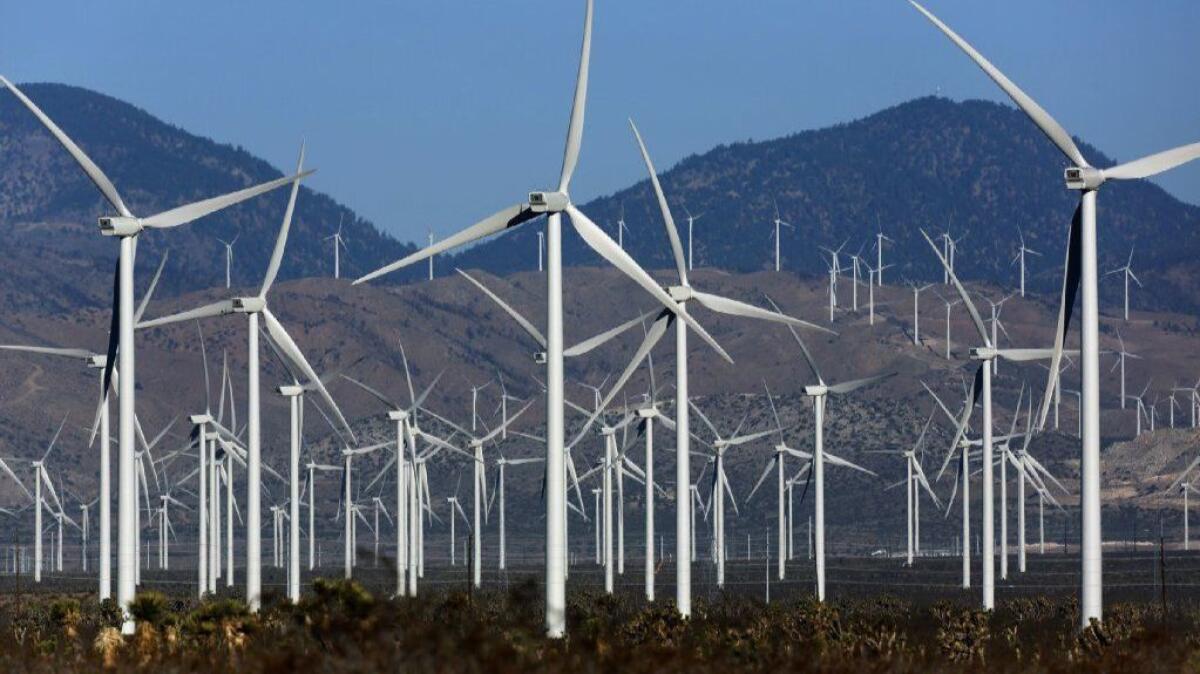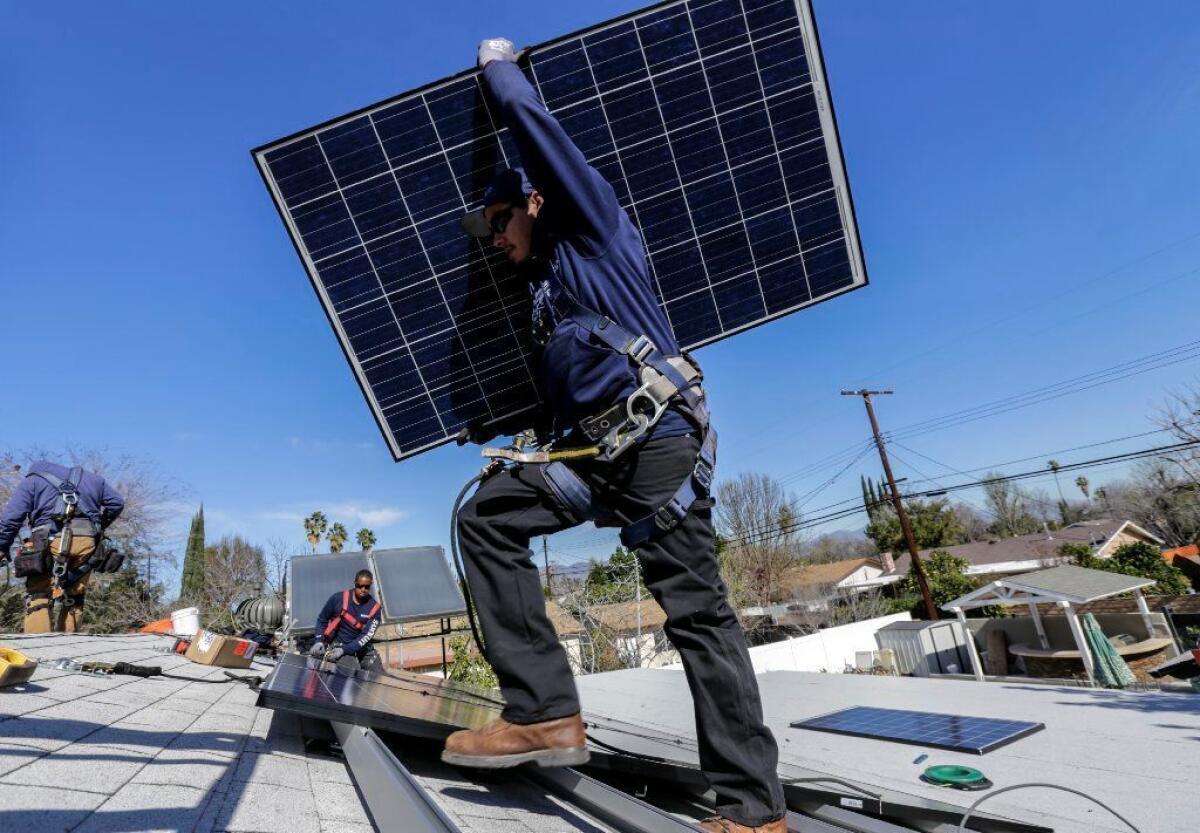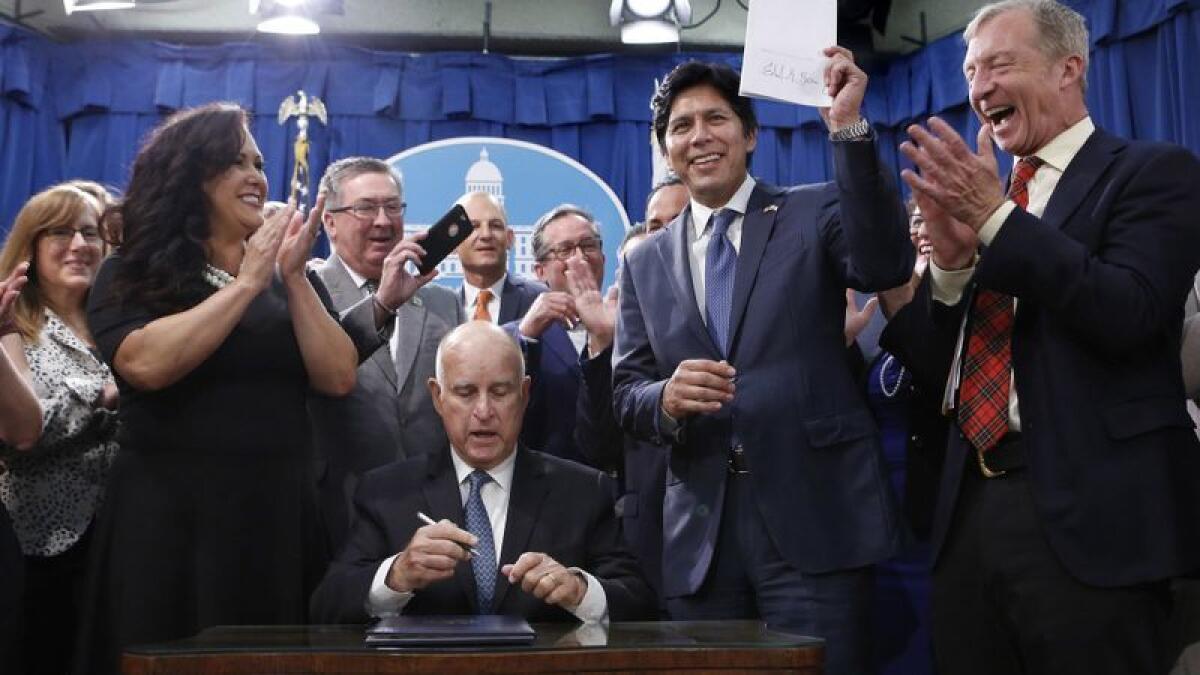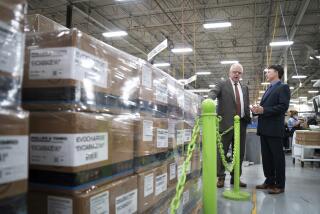California set a goal of 100% clean energy, and now other states may follow its lead

It’s been less than four months since California committed to getting all of its electricity from climate-friendly sources by 2045. But the idea is already catching on in other states.
At least nine governors taking their oaths of office this month, from Nevada to Michigan to New York, campaigned on 100% clean energy, or have endorsed the target since it was enshrined in California law. The District of Columbia also set a 100% clean energy goal last month. So did Xcel Energy, a Minneapolis-based utility that serves 3.6 million electricity customers across eight Western and Midwestern states.
The policy’s growing popularity is driven in part by market trends and technological advances that make it easier to envision a future in which fossil fuels are no longer burned for electricity. But experts say California’s recent passage of Senate Bill 100 is also playing a role.
“Sometimes other states don’t want to admit that they’re looking to California for leadership. But they really are,” said Carla Frisch from the Rocky Mountain Institute, a Colorado-based think tank that has worked with cities and states on energy policy.
As the world’s fifth-largest economy, California wields enormous power to influence environmental policy nationally and even globally. The state’s actions have reshaped how industries do business, changed people’s habits and set the agenda for other states and countries. Automakers, for instance, have been forced to build increasingly fuel-efficient cars for decades because of California’s authority to set tailpipe-emission rules stricter than those of the federal government.
The Golden State’s aggressive policies can also prompt a backlash. In the four-plus years since California lawmakers voted to ban single-use plastic bags at most stores, nine states have passed laws blocking local governments from enacting such bans.
California’s role as a global leader was front of mind of then-state Sen. Kevin de León as he crafted the 100% climate-friendly energy legislation. The Los Angeles Democrat had previously written a bill raising the state’s clean energy target to 50% by 2030. But within a few years, it had become clear the state could meet that goal far sooner than expected, without the massive economic disruption opponents had predicted.
“California has long shown the rest of the nation how to protect the environment while growing the economy,” De León said. “If California can do it, everyone else can.”
What’s unique about 100% clean energy, supporters say, is that it’s caught on with lawmakers and the public in a way other climate change policies haven’t.
Many economists say a market-based tool that puts a price on planet-warming carbon emissions is the cheapest way to fight climate change. But even in places with broad support for climate action, it’s been difficult to build support for those types of policies. Voters in Washington state, for instance, overwhelmingly rejected a carbon tax in 2016 and again in 2018.
How a tax on carbon has divided Northwest climate activists »
Adam Browning, executive director of the Oakland-based advocacy group Vote Solar, cited a common refrain among climate advocates — that the only two problems with a carbon tax are “carbon” and “tax.” Nobody likes taxes, and most people don’t have strong feelings about carbon.
A 100% clean energy policy, on the other hand, is simple and focused on positive change, Browning said. Supporters can highlight the potential benefits of cleaner air, job creation and cutting-edge technologies.
“It’s exciting to be a part of, it speaks to values, it speaks to solutions, and it speaks to things people like. And it has overwhelming bipartisan support,” Browning said.

The concept didn’t originate in California. Hawaii became the first state to pass a 100% clean energy mandate in 2015, and U.S. Sen. Jeff Merkley, an Oregon Democrat, introduced federal legislation to that effect in 2017. More than 100 cities have endorsed the concept, according to the Sierra Club, as have 150 major corporations that are part of the RE100 coalition.
But in the months since California passed its 100% clean energy mandate, the idea has gained significant political momentum.
Voters in Colorado, Connecticut, Illinois, Maine, Michigan, Nevada and Wisconsin elected new governors in November who signed a pledge from the League of Conservation Voters to support 100% clean energy by 2050. In several states, the new governors mark a dramatic shift from their predecessors.
In Maine, for instance, Democrat Janet Mills has replaced Republican Paul LePage, who issued a moratorium on new wind turbines and vetoed a bill to study how climate change would affect the state.
In Oregon, voters reelected Gov. Kate Brown, who also signed the League of Conservation Voters’ 100% clean energy pledge. In New Mexico, newly elected Gov. Michelle Lujan Grisham campaigned on a promise of 80% renewable energy by 2040 and has touted California’s 100% clean energy law as a success story. New York Gov. Andrew Cuomo also announced his support last month for 100% climate-friendly energy.
David Bookbinder, chief counsel for the Niskanen Center, a libertarian think tank in Washington, D.C., described the groundswell of support for 100% clean energy policies as a “political trend” first and foremost.
“These are all governors who are Democrats, and they’re all trying to be progressive. And saying ‘100% renewables’ is money in the bank as far as their base is concerned,” Bookbinder said.
The Niskanen Center encourages politicians to support a carbon tax as an economically efficient way to reduce emissions. Still, Bookbinder described the expanding support for 100% clean energy as a positive development in the fight against climate change. It shows that the public is beginning to take the problem seriously, he said, and that lawmakers see “political mileage” in committing to ambitious climate action.
That’s certainly the case in Colorado, where Jared Polis, who was sworn in as governor on Tuesday, made 100% renewable energy a key campaign promise. That pledge may have been a factor in Xcel Energy’s decision to become the first major U.S. utility to commit to 100% carbon-free electricity, with a target date of 2050. Xcel’s biggest electricity customer base is in Colorado.

Washington, D.C., has set the most aggressive target date, 2032, for getting off of fossil fuels. The nation’s capital also set a strict goal of all-renewable energy, meaning only naturally replenishing resources such as sunlight, wind and geothermal heat. California and Xcel set zero-carbon targets that could also include nuclear power or fossil-fueled power plants that capture carbon dioxide before it is emitted into the atmosphere.
For many of the newly elected governors, it’s unclear exactly what flavor of “100% clean energy” they’ll ultimately seek.
But whatever standards they endorse, the effects of simply setting the goal could be felt immediately, even with a target date 20 to 30 years in the future. Wade Schauer, a research director at the energy consulting firm Wood Mackenzie, said investors might hesitate to invest in gas-fired power plants in states looking to eliminate fossil fuels in the next few decades.
“Why would you want to go into New York and build a power plant that by 2035 would barely be running, and by 2040 wouldn’t be running at all?” Schauer asked. The adoption of 100% clean energy targets, he said, “could completely change the game” for natural gas.
California is aiming for 100% clean energy. But Los Angeles might invest billions in gas plants »
At the same time, goal-setting is the easy part. When it comes to eliminating fossil fuels from electricity, the devil will be in the details — and other states will be looking to California to see if it’s really possible.
The biggest issue California needs to work out: how to move beyond natural gas, the state’s largest source of electricity.
Some ideas are already being put into practice, such as batteries that store solar power for nighttime use, geothermal plants that generate clean energy around the clock and time-varying electricity rates that encourage people to use energy at different times of day. But it’s not yet clear how those policies and technologies will fit together, or how quickly California can radically reduce its use of gas.
Another proposal favored by former Gov. Jerry Brown is to merge California’s power grid with those of other Western states.
So far, the plan has been derailed by the thorny politics of red states and blue states working together. But in the long run, most energy experts say an expanded power grid that makes for easier sharing of electricity across state lines is one of the least expensive ways to meet 100% clean energy targets.
One other problem facing California: Cars and trucks, not electricity, are the state’s biggest source of planet-warming emissions. California already gets nearly one-third of its electricity from renewable sources. When nuclear and large hydropower plants are counted, the amount of electricity from zero-carbon sources rises to half. But the state has made far less progress transitioning away from oil-powered vehicles as the main source of transportation.
“It’s easy to switch from coal to gas and from gas to renewables. Relatively easy,” Bookbinder said. “Getting rid of the internal combustion engine is a whole nother thing.”
More to Read
Inside the business of entertainment
The Wide Shot brings you news, analysis and insights on everything from streaming wars to production — and what it all means for the future.
You may occasionally receive promotional content from the Los Angeles Times.











